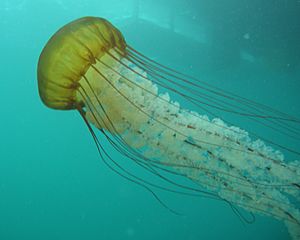West Coast sea nettle facts for kids
Quick facts for kids West Coast sea nettle |
|
|---|---|
 |
|
| The Pacific sea nettle (Chrysaora fuscescens). | |
| Scientific classification | |
| Genus: |
Chrysaora
|
| Species: |
fuscescens
|
The West Coast sea nettle (Chrysaora fuscescens), also called the Pacific sea nettle, is a beautiful type of jellyfish. It lives in the Pacific Ocean. If you accidentally touch one, its sting might feel a bit itchy, but it's usually not dangerous for people.
Where They Live
West Coast sea nettles mostly live near the coasts of California and Oregon. But you can also find them in colder waters up north, like the Gulf of Alaska. They even swim as far west as the seas near Japan and south to the Baja California Peninsula. So, they cover a lot of ocean!
What They Look Like
The West Coast sea nettle has a bell that is golden-brown, sometimes with a hint of red. This bell is the main body of the jellyfish. In the wild, their bells can grow very large, sometimes more than one meter (about three feet) wide! However, most of them are smaller, usually less than 50 centimeters (about 1.5 feet) across.
They also have long, white arms and 24 maroon-colored tentacles. These tentacles can be super long, reaching up to 3.6 to 4.6 meters (12 to 15 feet)! That's longer than a car!
How They Eat
Like most jellyfish, the West Coast sea nettle is a carnivore. This means it eats other animals. They catch their food using special stinging cells called nematocysts, which are found on their tentacles.
The sting from these nematocysts has a toxin, or poison. This toxin helps them catch their prey. Since sea nettles can't chase their food, they float and drift in the water. They spread out their long tentacles like a big net. When a small animal bumps into these tentacles, thousands of nematocysts fire. They shoot out tiny, barbed stingers that release a paralyzing toxin.
After the prey is stunned, the sea nettle's oral arms (which are near its mouth) begin to push the food into its mouth.
West Coast sea nettles eat many different things. Their diet includes tiny animals called zooplankton, crustaceans (like small crabs or shrimp), salps, small fish, and even the eggs and larvae of other sea creatures. They sometimes even eat other jellyfish!
Images for kids
See also
 In Spanish: Ortiga del Pacífico para niños
In Spanish: Ortiga del Pacífico para niños



